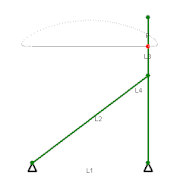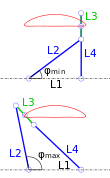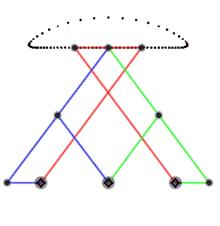The Chebyshev linkage is a mechanical linkage that converts rotational motion to approximate straight-line motion.
It was invented by the nineteenth-century mathematician Pafnuty Chebyshev, who studied theoretical problems in kinematic mechanisms. One of the problems was the construction of a linkage that converts a rotary motion into an approximate straight-line motion. This was also studied by James Watt in his improvements to the steam engine.[1]
The straight-line linkage confines the point P – the midpoint on the link L3 – on a straight line at the two extremes and at the center of travel. (L1, L2, L3, and L4 are as shown in the illustration.) Between those points, point P deviates slightly from a perfect straight line. The proportions between the links are
Point P is in the middle of L3. This relationship assures that the link L3 lies vertically when it is at one of the extremes of its travel.[2]
The lengths are related mathematically as follows:
It can be shown that if the base proportions described above are taken as lengths, then for all cases,
and this contributes to the perceived straight-line motion of point P.
Equations of motion
The motion of the linkage can be constrained to an input angle that may be changed through velocities, forces, etc. The input angles can be either link L2 with the horizontal or link L4 with the horizontal. Regardless of the input angle, it is possible to compute the motion of two end-points for link L3 that we will name A and B, and the middle point P.
while the motion of point B will be computed with the other angle,
And ultimately, we will write the output angle in terms of the input angle,
Consequently, we can write the motion of point P, using the two points defined above and the definition of the middle point.
Input angles
The limits to the input angles, in both cases, are:
See also
- Chebyshev's Lambda Mechanism
- Watt's linkage, a similar straight-line mechanism with the direction of one of the arms reversed.
- Straight line mechanism
- Scott Russell linkage
- Hoeckens linkage (4-bar linkage that converts rotational motion to approximate straight-line motion)
- Peaucellier–Lipkin linkage ( an 8-bar linkage that gives perfect linear motion)
- Four-bar linkage
References
- ^ Cornell university - Cross link straight-line mechanism
- ^ Gezim Basha Archived August 19, 2014, at the Wayback Machine - Rotation to approximate translation using the Chebyshev Linkage
External links
- Cornell university, "How to draw a straight line, by A.B. Kempe, B.A."
- A simulation using the Molecular Workbench software
- A Geogebra simulation of the linkage


